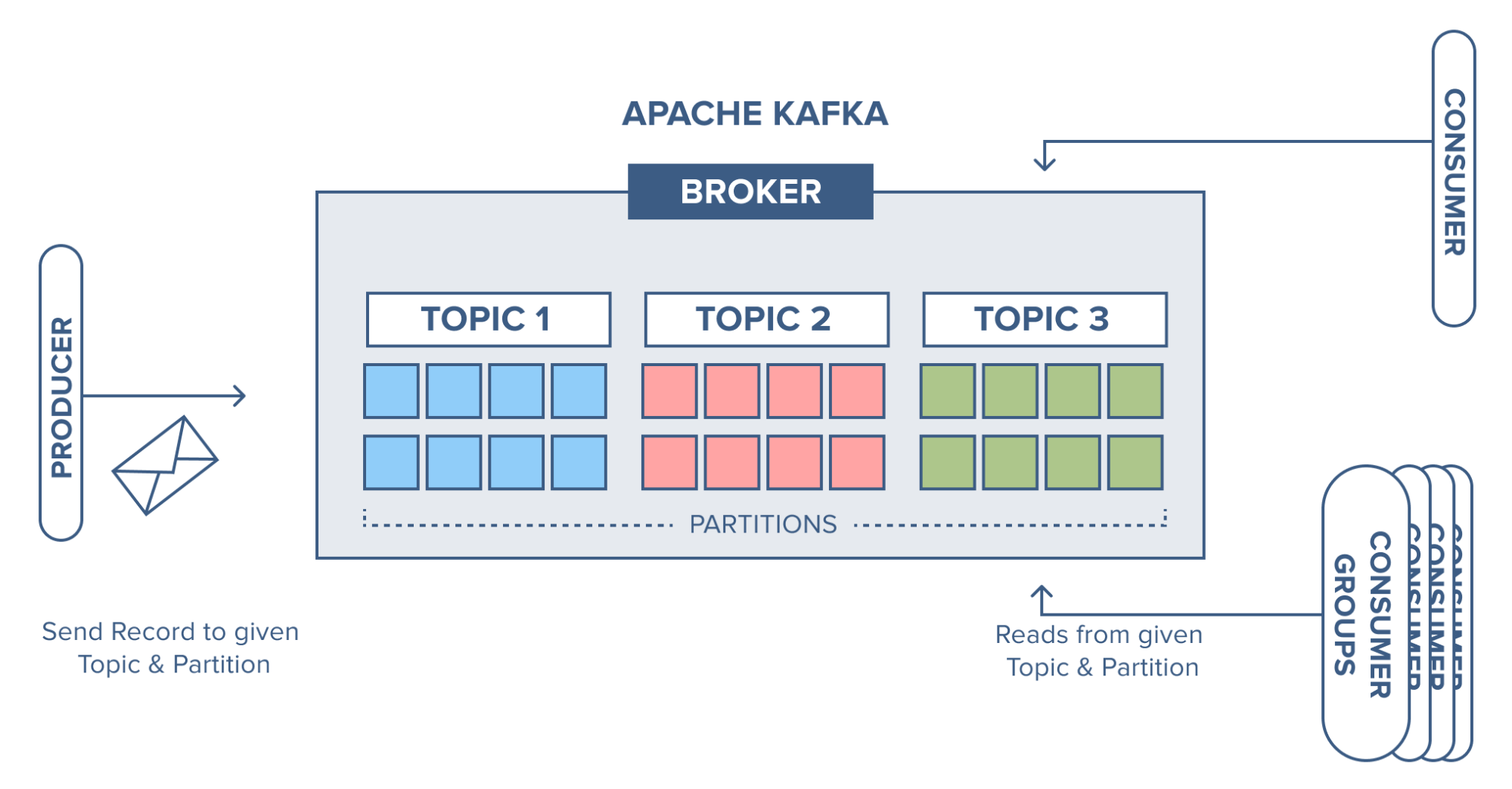Apache Kafka is a distributed streaming platform, that allows us to process streams of record in real-time. The Apache Kafka achieve this by the help of following components.
- Producer
- Kafka Cluster
- Brokers
- Topic
- Partitions
- Consumers
Producer:
Apache Kafka Producers are applications that generate data and write it to one or more topics in a Kafka cluster. Producers are responsible for choosing which partition to write to, serializing the data, and sending it to the broker. The producer can also choose to receive acknowledgements from the broker to ensure that the data has been written to the cluster successfully.
Here are some key features of Apache Kafka producers:
- Partitioning: Producers can choose which partition to write to by providing a partition key or by using a custom partitioning strategy. This allows for load balancing and fault tolerance.
- Serialization: Producers must serialize the data they want to send to the broker. Apache Kafka provides several serialization libraries, including Apache Avro, Apache Thrift, and JSON, among others.
- Batching: Producers can choose to batch multiple records into a single request to the broker, which can improve performance and reduce network overhead.
- Compression: Producers can choose to compress the data before sending it to the broker to reduce network overhead. Apache Kafka supports several compression algorithms, including gzip, snappy, and lz4.
- Acknowledgements: Producers can choose to receive acknowledgements from the broker to ensure that the data has been written to the cluster successfully. The producer can choose between receiving an acknowledgement after the data has been written to the leader broker, or after the data has been written to a certain number of replicas.
- Error handling: Producers must handle errors that may occur during the write process, such as broker failures, network issues, and serialization errors. Apache Kafka provides several configuration options to help producers handle errors, including retries, timeouts, and backoff strategies.
Kafka Clusters:
A Kafka cluster is a group of one or more brokers that work together to manage the storage and distribution of data in the cluster. Each broker is responsible for one or more partitions in one or more topics.
Here are some key features of a Kafka cluster:
- Scalability: A Kafka cluster can be scaled horizontally by adding more brokers to the cluster. This allows for increasing the storage capacity, processing power, and fault tolerance of the cluster.
- Data replication: The data in a Kafka cluster is replicated across multiple brokers to ensure data availability in case of broker failures. The replication factor, or the number of replicas for each partition, can be configured for each topic.
- Partitioning: Data in a Kafka cluster is partitioned into several partitions for each topic. This allows for distributing the data across multiple brokers for parallel processing and fault tolerance.
- Leader election: For each partition, one broker is elected as the leader, and the other brokers act as followers. The leader is responsible for accepting writes and responding to read requests for a partition, while the followers replicate the data from the leader.
- Load balancing: Producers and consumers can use the same topic and partition, and the data is automatically load-balanced among them. This allows for parallel processing and increased performance.
- Fault tolerance: A Kafka cluster is designed to be highly available and fault-tolerant. In case of broker failures, the data is automatically replicated to other brokers, and leader elections are handled by ZooKeeper to ensure that the cluster continues to operate.
Kafka Brokers
A broker in Apache Kafka is a server that stores and processes data in a Kafka cluster. A Kafka cluster consists of one or more brokers, and each broker is responsible for serving a portion of the data stored in the cluster.
Here are some key features of a Kafka broker:
- Data storage: Brokers store the data in the form of topics and partitions. Each broker can store multiple partitions from multiple topics, and each partition is stored as a sequence of records.
- Data processing: Brokers are responsible for processing the data produced by producers and consumed by consumers. They handle the request for writing and reading data, and manage the offset tracking for consumers.
- Load balancing: Brokers distribute the load evenly across the cluster by partitioning the data and assigning partitions to different brokers. This allows for horizontal scaling of the cluster and improved performance.
- Replication: Brokers also act as replicas for the partitions they store, and replicate data to other brokers to ensure data availability in case of broker failures.
- Leader election: For each partition, one broker is elected as the leader, and the other brokers act as followers. The leader is responsible for accepting writes and responding to read requests for the partition, while the followers replicate the data from the leader.
- Configuration: Brokers are configurable, and administrators can set properties such as the number of partitions, the replication factor, and the retention policy for each topic.
Kafka Topics
A Kafka topic is a named stream of records within a Kafka cluster. Topics are the primary unit of data organization and distribution in a Kafka cluster. Each topic can have multiple partitions and replicas, which allow for parallel processing, scalability, and fault tolerance.
Here are some key features of a Kafka topic:
- Data organization: Topics provide a way to organize data into different streams within a Kafka cluster. This allows for separating different types of data and processing them separately.
- Partitions: Topics are divided into multiple partitions, which allow for parallel processing and fault tolerance. Each partition is a ordered, immutable sequence of records that is stored on one or more brokers in the cluster.
- Replication: Each partition in a topic is replicated across multiple brokers to ensure data availability in case of broker failures. The replication factor, or the number of replicas for each partition, can be configured for each topic.
- Retention policy: Topics can have a retention policy that defines how long data should be kept in the cluster. This allows for configuring the amount of storage required for each topic, and for purging old data to free up space.
- Compression: Topics can have a compression type that defines the algorithm used to compress the data. This allows for reducing network overhead and storage requirements.
- Access control: Topics can have access controls that define who can write to and read from the topic. This allows for controlling access to sensitive data and enforcing security policies.
Kafka Partition
A partition in Apache Kafka is a unit of data organization and distribution within a topic. Each topic in a Kafka cluster can have multiple partitions, which allows for parallel processing, scalability, and fault tolerance.
Here are some key features of a Kafka partition:
- Ordering: Partitions provide a way to order data within a topic. Records within a partition are stored and retrieved in the order in which they were produced.
- Scalability: By dividing a topic into multiple partitions, the amount of data that can be stored and processed can be increased, allowing for greater scalability.
- Data replication: Partitions are replicated across multiple brokers to ensure data availability in case of broker failures. The replication factor, or the number of replicas for each partition, can be configured for each topic.
- Parallel processing: Partitions allow for parallel processing of data by different consumers. Each consumer can read data from a different partition, allowing for increased processing speed and reduced latency.
- Leader election: For each partition, one broker is elected as the leader, and the other brokers act as followers. The leader is responsible for accepting writes and responding to read requests for the partition, while the followers replicate the data from the leader.
- Offset management: Each partition has an offset, which is a unique identifier for the position of a record within the partition. Consumers use the offset to track their position within a partition and to determine which records they have processed.
Kafka Consumers
Consumers in Apache Kafka are applications or processes that read and process data from topics in a Kafka cluster. Consumers subscribe to one or more topics and receive data from the partitions of those topics in real-time.
Here are some key features of a Kafka consumer:
- Subscription: Consumers subscribe to one or more topics and receive data from the partitions of those topics. They can also dynamically add or remove topics to their subscription.
- Offset tracking: Consumers track their position within the partitions they are consuming by maintaining an offset for each partition. The offset is a unique identifier for the position of a record within the partition.
- Load balancing: Consumers can be organized into consumer groups, and the partitions of a topic are assigned to consumers within a consumer group. This allows for load balancing and parallel processing of data.
- Fault tolerance: Consumers can be automatically reassigned to other brokers if a broker fails. This helps to ensure that the data continues to be processed in the event of broker failures.
- Serialization and deserialization: Consumers must deserialize the data they receive into a format that they can process. They can use built-in serializers and deserializers provided by Kafka, or they can implement their own custom serialization and deserialization logic.
- Processing: Consumers process the data they receive from the topics and can perform actions such as storing the data in a database, aggregating the data, or forwarding the data to another system.

